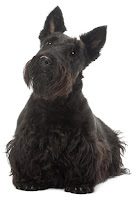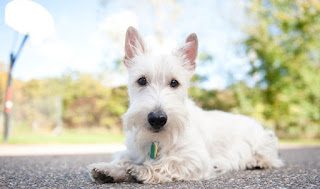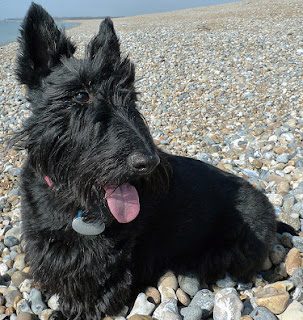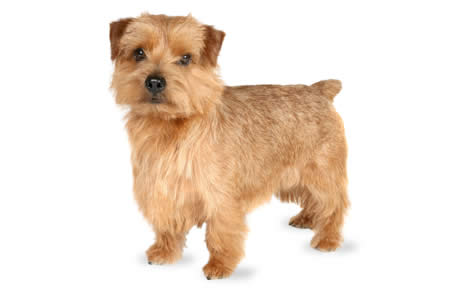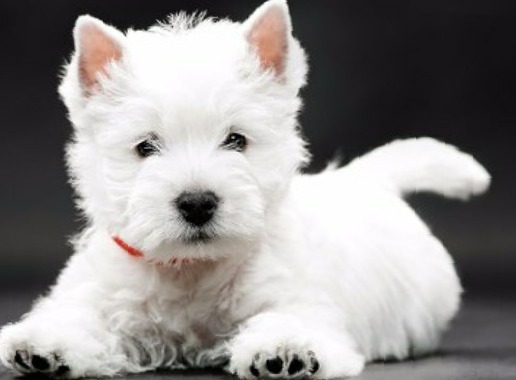AKC group: Terrier
UKC group: Terriers
Average lifespan: 11 to 13 years
Average size: 18 to 22 pounds
Coat appearance: Dense, Harsh and Rough, and Wire
Coloration: Black is the color typically, but they also come in gray, steel, brindle and wheaten
Hypoallergenic: Yes
Best Suited For: Families with children, singles, seniors, apartments, houses with/without yards
History
There is a lot of confusion regarding the Scottish Terrier’s background, as all terriers in Scotland are referred as Scotch or Scottish Terriers. Adding to the confusion is the fact that the modern Scottish Terrier was originally placed under the group of the Skye Terriers, denoting a family of terriers belonging to Scottish Isle of Skye.
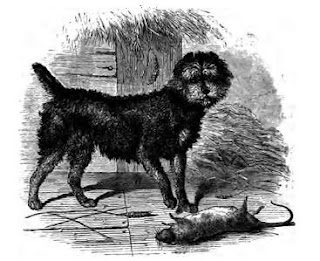 |
| A Scotch Terrier, published in 1859 |
Irrespective of the origin, the earliest Scottish Terriers were first documented in the late 19th century, belonging to a group of hardy Highlanders whom they served as vermin hunters. The first breed standard was drafted by J.B. Morrison and later published in Vero Shaw’s Illustrated Book of the Dog in 1880. John Naylor is credited with introducing the breed to the United States in 1883.
The Scottish Terrier’s popularity gradually grew until World War II, after which its popularity surged. The Scottish Terrier is also the only breed of dog that has lived in the White House three times, beginning with Fala, a male Scottish Terrier gifted to President Franklin D. Roosevelt. President Roosevelt rarely went anywhere without his steady companion, even being buried by next to Fala. Most recently, President George W. Bush has owned two Scottish Terriers, Barney and Miss Beazley. Today, the Scottish Terrier is a popular pet and show dog.
The Scottish Terrier’s character and personality are a bit like the lonely moors of his homeland. He’s a serious guy, not particularly jolly, and he approves of dignity and reserve. He’s opinionated, as well as independent and smart as a whip. He tends to be aloof . A Scottie doesn’t respond much to people who oooh and ahh over him while he’s out and about. He’s slow to accept anyone outside the family, but his devotion to his own people is legendary. He needs to live inside the house, because companionship is his mainstay. Sensitive to praise and anger, he’s good at adapting to the changing moods of a household. When you’re quiet, he’ll be quiet ; when you’re ready for a walk, he’ll bound outdoors with you.
Remember his background: he’s a true terrier. If another dog provokes him, he’ll fight to the end. If other dogs leave him alone, he leaves them alone.
It’s important, actually critical, to take your Scottie to socialization classes starting when he’s a puppy. Inviting friends and family over or going to busy places with him while he’s young will tamp down his general distrust of strangers. Left unchecked, that can translate into aggression when the dog is an adult — so start training your Scottie puppy from the moment you bring him home.
Health Problems
With a higher propensity to developing cancers than other dogs, it’s important to monitor your Scottish Terrier’s health with a close eye. Frequent trips to the veterinarian will be required particularly as your dog advances in age. Other issues like Scottie Cramp and von Willebrand’s disease might have interesting names but you don’t really want to see your terrier develop them. Be sure to keep your terrier plenty active – you might be surprised how durable they can be.
The Scottie is active and can become destructive when bored and underexercised. He loves to go for walks, but running is not part of his plan for the day. He has to be leashed for walks because he is a hunter, after all, and he will see the squirrel but not the car.
He likes water but can’t swim, and that’s a bad conflict. He’ll sink like a stone because of his short legs and heavy body. Scotties and uncovered swimming pools are a disaster waiting to happen, which is why Scottie Rescue groups prefer not to place them in homes with pools.
Crate training benefits every dog and is a kind way to ensure that your Scottie doesn’t have accidents in the house or get into things he shouldn’t. A crate is also a place where he can retreat for a nap. Crate training at a young age will help your Scottie accept confinement if he ever needs to be boarded or hospitalized. Never stick your Scottie in a crate all day long, however. Scotties are people dogs, and they aren’t meant to spend their lives locked up in a crate or kennel.
This dog is good for apartment living. It is moderately active indoors and will do okay without a yard. Prefers cool climates.
Trainability
Scottish Terriers are not for softies who are prone to bend the rules. Scotties have very high self esteem and assume themselves to be the leader of the house. Training should begin early and should be conducted with excited praise and lots of treats in order to keep him interested. Harsh discipline will cause a Scottie to simply disregard you and your rules. Absolute consistency is a must in order to raise a well behaved Scottish Terrier, as they see rule-bending as an open invitation to take over.
Scotties should be socialized from an early age to accept visitors into his home. While all Scotties are discriminating, if not properly socialized, they can become overly suspicious of strangers, which can be difficult to live with.
Activity Requirements
Scotties can adjust to any living arrangement, be it a small apartment or a sprawling estate. They need to be exercised daily, but a brisk walk around the neighborhood will cover their activity requirement. If you have a fenced yard, your Scottie will entertain himself by chasing squirrels, birds and butterflies. They do not have the athleticism or endurance to jog or take long hikes, however, so they are well suited for a more “indoorsy” family.
The Scottie’s sculptured appearance requires some work in the form of regular brushing and clipping, so much so that the Scottish Terrier Club of America publishes an illustrated grooming guide. The heavy-duty manual has laminated pages in a three-ring binder and contains grooming instructions for puppies, pets, and show dogs.
At a minimum, you will need to brush the coat one to three times a week. Don’t miss the belly or the areas where the legs meet the body or they will become tangled. Be sure you brush all the way down to the skin. If you just go over the top of the coat, you’ll miss a lot of tangles. After you brush the coat, go through it again with a comb to remove any remaining loose hairs. Comb out the beard and other facial hair, too, especially after meals or after your Scottie drinks. You should also learn how to strip the coat, the process of removing dead hair by hand, which is necessary twice a year. Learn to clip him yourself or take him to a professional groomer if you want him to have the distinctive Scottie silhouette.
The rest is basic care. Trim the nails as needed, usually every week or two. Brush the teeth frequently with a vet-approved pet toothpaste for good overall health and fresh breath.
He’s so good with children that he’s been called a nanny — but, like any terrier, the Scottie will react poorly to his tail or hair being pulled, and he’s not well suited to the noise and movements of toddlers and very young children. But with well-behaved children, he’s a champion and he will appoint himself their guardian.
A true terrier, he can be aggressive with other dogs, particularly those of the same sex. Although he’s not a sparring dog, if he wants to start a fight or responds to another dog’s challenge, it can be a real problem. He’s fine with those dogs he’s been raised with.
Because he’s a hunter, he is not well suited to smaller pets. He may or may not tolerate a cat, but he’s definitely bad news around small mammals such as hamsters or rats. To him, they’re fast-food snacks. It’s hardwired in the Scottie to go after vermin — it’s not a choice. Set him up for success by not putting him in a situation where he has to fight his own nature, because he won’t.
Is the Scottish Terrier the Right Breed for you?
Moderate Maintenance: Regular grooming is required to keep its fur in good shape. Professional trimming or stripping needed.
Minimal Shedding: Recommended for owners who do not want to deal with hair in their cars and homes.
Difficult Training: The Scottish Terrier isn’t deal for a first time dog owner. Patience and perseverance are required to adequately train it.
Fairly Active: It will need regular exercise to maintain its fitness. Trips to the dog park are a great idea.
Not Good for New Owners: This breed is best for those who have previous experience with dog ownership.
Good with Kids: This is a suitable breed for kids and is known to be playful, energetic, and affectionate around them.
Did You Know?
Scottish Terriers have lived in the White House with three presidents: Franklin Delano Roosevelt, Dwight D. Eisenhower, and George W. Bush.
Famous Scotties and popular culture
 |
Fala at the Franklin Delano Roosevelt Memorial,
the only Presidential dog so honoured. |
- The Scottie and the German Shepherd are the only breeds of dog that have lived in the White House more than three times. President Franklin D. Roosevelt was renowned for owning a Scottie named Fala, a gift from his distant cousin, Margaret Suckley. The President loved Fala so much that he rarely went anywhere without him. Roosevelt had several Scotties before Fala, including one named Duffy and another named Mr. Duffy. Eleanor Roosevelt had a Scottish Terrier named Meggie when the family entered the White House in 1933. More recently, President George W. Bush has owned two black Scottish Terriers, Barney and Miss Beazley. Barney starred in nine films produced by the White House.
- Other famous people who are known to have owned Scotties include: Queen Victoria, Eva Braun, Dwight D. Eisenhower, Jacqueline Kennedy Onassis, Ed Whitfield, Rudyard Kipling and President of Poland, Lech Kaczynski. Actress Tatum O’Neal owned a Scottish Terrier. She was said to be so saddened by her dog’s death to cancer and old age that she relapsed into drugs.
- The Scottie is also renowned for being featured in the popular board game, Monopoly, as a player token. When the game was first created in the 1930s, Scotties were one of the most popular pets in the United States, and it is also one of the most popular Monopoly game tokens, according to Matt Collins, vice president of marketing for Hasbro. A Scottish Terrier named Dulcinea is a scene-stealer in the 1998 Latin American novel Yo-Yo Boing! by Giannina Braschi.
 |
The Scottie was introduced
as a token in the 1950s |
- In May 2007, Carnegie Mellon University named the Scottish Terrier its official mascot.The Scottie had been a long-running unofficial mascot of the university, whose founder’s Scottish heritage is also honored by the official athletic nickname of “Tartans”. Agnes Scott College in Decatur, Georgia also uses the Scottie as their mascot.The dog’s image is a symbol for the Radley brand of bags. The amateur athletics organisation Jogscotland has an anthropomorphic Scottish Terrier as its mascot.





